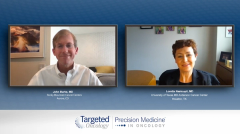
CD19 as a Treatment Target in Patients With R/R DLBCL
An overview of CD19 as a treatment target for patients with relapsed/refractory diffuse large B-cell lymphoma (DLBCL).
Episodes in this series

Loretta Nastoupil, MD: Why is CD19 an attractive target in relapsed/refractory [diffuse] large B-cell lymphoma?
John Burke, MD: It’s a transmembrane glycoprotein. It regulates B-cell receptor signaling. The main reason is that it’s present on all B-cells and B-cell malignancies, and it can be targeted with monoclonal antibodies and other things, like CAR [chimeric antigen receptor] T-cell therapies, that can bind to it. Why don’t you tell us about the different ways of targeting CD19?
Loretta Nastoupil, MD: We first had approval of the CAR T-cell therapies, these are autologous CARs. That means patients have to undergo assessment at a treating center, they have to have insurance approval, cells are… sent off to a central manufacturing site. Usually, it takes about 3 to 4 weeks to get [results] of those cells. Then they undergo lymphocyte depleting chemotherapy and infusion of those cells, monitoring at that treating center for a minimum of 4 weeks. Sometimes they’re referred back to their originating site for late toxicity monitoring. We currently have 3 CD19-approved CARs for relapsed large B-cell lymphoma in the third line or later space: Axi-cel [axicabtagene ciloleucel], tisa-cel [tisagenlecleucel], and liso-cel [lisocabtagene maraleucel]. We have approvals for CAR T[-cell] and other B-cell malignancies, such as mantle cell lymphoma and follicular lymphoma. The reason why these are effective strategies is because, in the refractory setting, we’ve seen responses that are durable in at least 40% of patients.
The toxicities are also worth discussing as you have the acute toxicity, which is primarily cytokine release syndrome and/or ICANS [immune effector cell-associated neurotoxicity syndrome], which is neurologic toxicity. It is a spectrum. In my experience, the CRS [cytokine release syndrome] is most commonly fever and is occasionally associated with hypoxia or hypotension, rarely severe end organ compromise, sometimes including respiratory failure, cardiogenic shock, etc. Those are rare. The ICANS are more unpredictable and may be a larger spectrum, all the way from mild tremor to full-blown confusion or altered consciousness where patients are no longer able to regard or answer questions, to even seizure activity or cerebral edema.
Fortunately, the severe end of that spectrum is uncommon, but it can be unpredictable outside of the construct, disease burden, and sometimes the comorbidities in functional status of the patient. The biggest issue I foresee with CAR T is that it is logistically challenging. Ideally, you have to refer patients to a treating center as soon as possible to start the insurance approval process, which takes anywhere from 1 to 6 weeks. Let’s say we’re closer, now, to 1 to 3 weeks for most patients. That’s before we can even set them up for collection and manufacturing, which tacks on another 3 to 4 weeks. I recognize that this does select out for patients who have disease that will allow them that time. Then we have the acute monitoring, which is done in the treating center, but the late toxicity monitoring is something that we oftentimes share with our community oncologists, which is primarily monitoring for infection. Hypogammaglobulinemia can result from B-cell aplasia, which, in the setting of COVID-19, can be particularly challenging, and then prolonged or persistent cytopenia. Neutropenia, anemia, and thrombocytopenia can linger for months. These are more lined with significant immune suppression and chemotherapy monitoring and management.
John Burke, MD: I have another question for you about CAR T. I don’t treat CAR Ts, so when I see someone who needs that, I would refer them to someone like you. What do you tell your patients their likelihood of responses [are]? Of course, you want not only a quick response, but you also want your response to last a long time. What are you seeing from the longer-term follow-up of these trials, and how do you counsel your patients on their chances of response? Do you see the different products behaving differently in that way, or do you feel they’re all relatively similar, in terms of their long-term efficacy?
Loretta Nastoupil, MD: If you look at the long-term outcomes, they’re more similar than different. I fully acknowledge the patient characteristics, so the study populations were different. In my clinical experience—which we’ve now treated over 200 standard of care patients with CAR T in the last 2 and a half years—axi-cel is the most likely to give a durable outcome, even in refractory, high-grade patients that are progressing quickly. Liso-cel and tisa-cel are going to be better tolerated, so that factors into my decision. Even if I have a patient [and] I’m a little nervous that their disease is growing quickly, I acknowledge that these are patients that have already gotten to me. I don’t even have the conversation upfront with patients about [whether] they’re appropriate for CAR T, that’s rare.
When they’re coming in to see me, it’s usually already been discussed, but I do tell them that we’ve got about a 40% chance, and that 40% chance is a cure, 60% of patients fail—and usually fail quickly—generally within the first 3 months, if they are going to fail, that’s going to be the timeline. If they’re in a CR [complete remission] at month 3, there’s a good chance that those patients are going to remain in a complete remission and that can last for years. It is a situation where it’s resource intense upfront, but we get our answer quickly regarding whether it’s going to work.
Transcript edited for clarity.







































